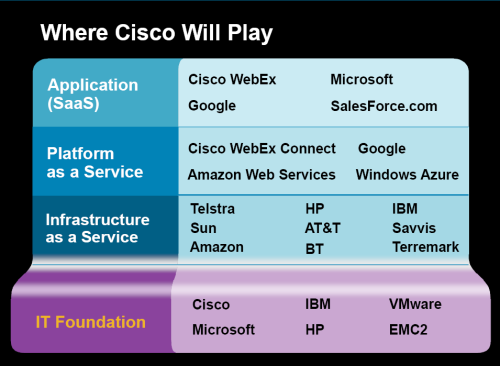Look into the world’s tech crystal ball and you’ll see only clouds. Even with my limited divination skills, this trend isn’t hard to spot.
For the past year or so, many tech vendors — e.g. IBM, Microsoft, Oracle — are jumping on and touting clouds as the next big thing. Now Cisco is taking up the banner charge and announcing their strategy and intent to attack this space.
At a telepresence media/analyst session held yesterday at Cisco offices in Asia and US, Cisco’s CTO Padmasree Warrior and senior VP of the software group Doug Dennerline fielded questions on Cisco’s push into clouds.
Firstly, definitions. The over-hyped, fuzzy phrase “clouds” can mean wildly different things to different people, and I have gone off on rants before on what exactly do you mean when you talk about clouds. At least Cisco defined what exactly cloud computing means to them, and here’s their verbatim definition:
Cloud computing: IT resources and services that are abstracted from the underlying infrastructure and provided on-demand and at-scale in a multi-tenant environment.
Sigh. Basically it’s virtualization in the data centre. Not surprising, if you think about Cisco’s recent aggressive pushes into this space. They added one more line that today’s clouds are “associated with an off-premise, hosted model”, but the suggestion is that it need not be. Well, if you ask me, take away this part of the definition and “cloud” as a term becomes very weak. Anyway, I digress.
So where in this space is Cisco playing at? They defined four categories in clouds, and here’s a diagram from them.

Basically, Cisco sees opportunity in three of these four tiers that they defined: software as a service (SaaS), platform as a service (aka creating a platform for a third party to sell their SaaS on your platform) and the underlying IT infrastructure, which is Cisco’s core bread and butter. The infrastructure as a service is an area they are not looking at; they’ll rely on partners to roll this out.
My take on this? Cisco isn’t saying much in specifics. Besides broad strokes that they are going to play in this space, many questions were unanswered, like how are they competing with software vendors on unified communications (UC)/collaboration products (are they in the first place? to what extent?), how to tweak Cisco’s channel partners programme for cloud so that it doesn’t cannibalize their on-prem businesses, etc.
But it does signal Cisco’s ambition. Cisco believes that enterprise customers will eventually outsource parts of their IT infrastructure to external clouds (reasons: economies of scale, commodity services, etc.), yet keep much infrastucture internally for security and control reasons. And being a network vendor that girds the infrastructure for many enterprises, they believe they are best placed to cobble up and federate external clouds with internal virtualized network solutions. Why let other vendors eat up so much of the IT infrastructure and services stack when you can do this?
Therein lies the danger. Simon Piff, program director of IDC for AP storage research, whom I met at the event, said: “Cisco will potentially alienate more partners with this.” He mentioned that they have already alienated many long time partners like HP, IBM and Dell by moving into the data centre with blades and commodity servers, and more will likely come with their push upwards into clouds and SaaS. Cisco’s ambition is definitely something the rest of the big technology players won’t discount and will watch out for.
But with big ambition comes big prizes as top dog, and Cisco has deep pockets. “You never know, maybe Cisco will emerge as the next IBM”, Simon said.




